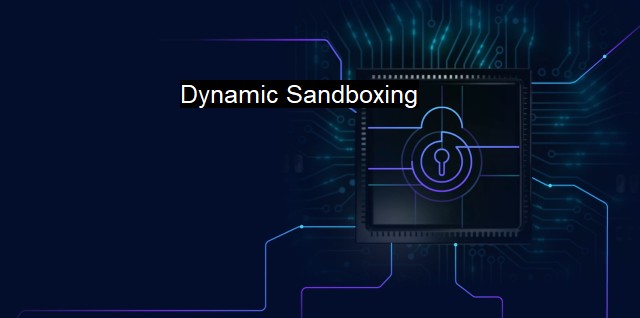What is Dynamic Sandboxing?
Dynamic Sandboxing: A Revolutionary Cybersecurity Mechanism for Malware Protection, Detection, and Analysis in Contained Environments
Dynamic Sandboxing, in the realm of cybersecurity and antivirus technologies, is an advanced and innovative security feature that serves to isolate potentially dangerous programs or files in a controlled environment. Thus, these potential harmful programs can be executed or run safely without causing any harm or damage to the primary system.The term "Sandbox" is common to multiple disciplines, signifying a restricted, controlled environment. Similar to the sandbox children play in, where they can experiment within a confined space that's separate from the broader environment. In cybersecurity and antivirus mechanisms, the concept is analogous, except the sandbox here is a safe space for experimenting with potentially malicious software (malware).
Dynamic Sandboxing goes a step ahead from the traditional Sandbox usage. It employs advanced algorithms that can "learn" and "adapt" from constant inflow of online threats and malware. The so-named "dynamic" characterization refers to its competent ability to adapt swiftly and respond effectively to ever-evolving cyber threats.
The rise of this practice in cybersecurity echoes the fast-paced nature of cyber threats: hackers and malicious programs are continually evolving, figuring out ways to bypass static defence systems. Static antivirus models base their safety measures on predefined threat patterns— but these aren’t effective with new, never-seen-before threats. In the always-changing realm of cyber-threats, holding static is basically tantamount to moving backwards. This necessitates a dynamic operation system like the Dynamic Sandboxing.
There's another advantageous aspect to dynamic sandboxing which makes it stand out among security tools; the detailed analysis reports of threats. By mimicking a full-production environment, sandboxing allows threats to expose their harmful intentions, monitored closely in an isolated virtual environment. This report accommodates details of the malware's execution flow, network activities, processes established, registry modifications, files created, and more in detail. These insights provide firms with a comprehensive understanding on malware behaviour, tactics, potential impacts, and resources affected on system.
Such a detailed review can serve many purposes, as it can prime cybersecurity teams to catch any suspicious or anomalous activity in the live, production environment. It would help in responding more accurately upon detecting similar threats in the future. It fundamentally increases the chances of preventing malware from reaching primary networks or systems, minimizing potential harm.
It is worth noting that dynamic sandboxing is resource intensive. It demands powerful hardware and comparatively larger amounts of processing power. It's important to be ready to cater to those requirements in the initial stage itself while opting for dynamic sandboxing solutions.
Despite the higher resource requirements, companies invest in dynamic sandboxing because they understand this advanced approach's potential returns, and their cybersecurity importance can't be overstated. The dynamic nature which allows it to "learn" from incoming threats plays an invaluable role in preventing cyber-attacks.
To sum up, dynamic sandboxing is more than a virtual space to examine dubious software safely. Its contribution extends to studying threats in detail, adaptively learning from these and providing high-end protection through mitigating possible threats from affecting the core system. As malware continues to evolve and pose challenges to the current cyber landscape, dynamic sandboxing consolidates its place as a resolute defense mechanism in cybersecurity.

Dynamic Sandboxing FAQs
What is dynamic sandboxing in cybersecurity?
Dynamic sandboxing is the technique used in cybersecurity to detect and analyze malware in a controlled virtual environment. This technique involves isolating suspicious files or programs and running them in a simulated environment to observe their behavior and determine whether they are malicious or not.How does dynamic sandboxing work in antivirus software?
In antivirus software, dynamic sandboxing involves creating a virtual environment or container where a suspicious program can be executed safely. The software then monitors the program's behavior and checks for any malicious activity. If the program is found to be malicious, the antivirus software can then take appropriate action, such as quarantining or removing the file.What are the benefits of dynamic sandboxing in cybersecurity?
Dynamic sandboxing provides several benefits in cybersecurity, including the ability to detect and analyze new and unknown malware, improved accuracy in detecting malware, and increased protection against zero-day attacks. It also helps to reduce false positives and negatives by providing a more comprehensive analysis of suspicious files.Are there any limitations to dynamic sandboxing in cybersecurity?
While dynamic sandboxing is an effective technique for detecting and analyzing malware, it is not foolproof. Some malware can detect and evade sandboxing environments, and some sophisticated malware can take steps to disguise their malicious activity. Additionally, dynamic sandboxing can be resource-intensive and may slow down system performance.| | A | | | B | | | C | | | D | | | E | | | F | | | G | | | H | | | I | | | J | | | K | | | L | | | M | |
| | N | | | O | | | P | | | Q | | | R | | | S | | | T | | | U | | | V | | | W | | | X | | | Y | | | Z | |
| | 1 | | | 2 | | | 3 | | | 4 | | | 7 | | | 8 | | |||||||